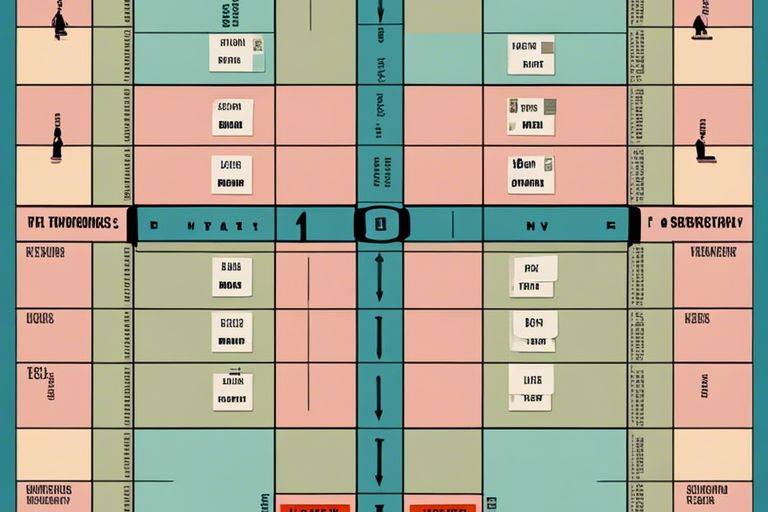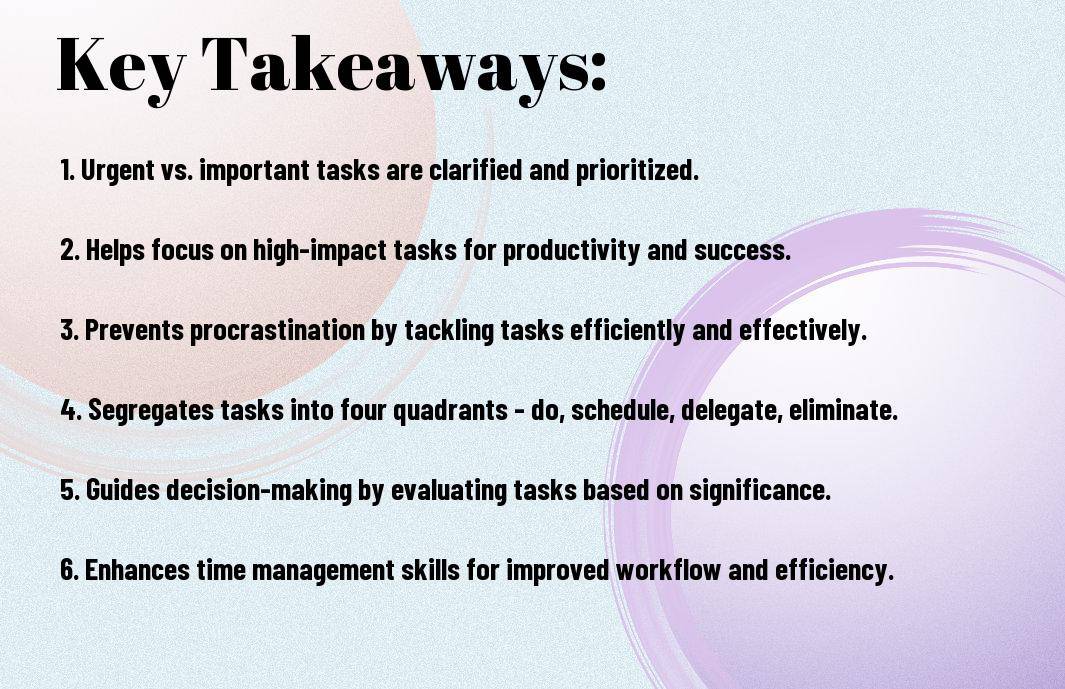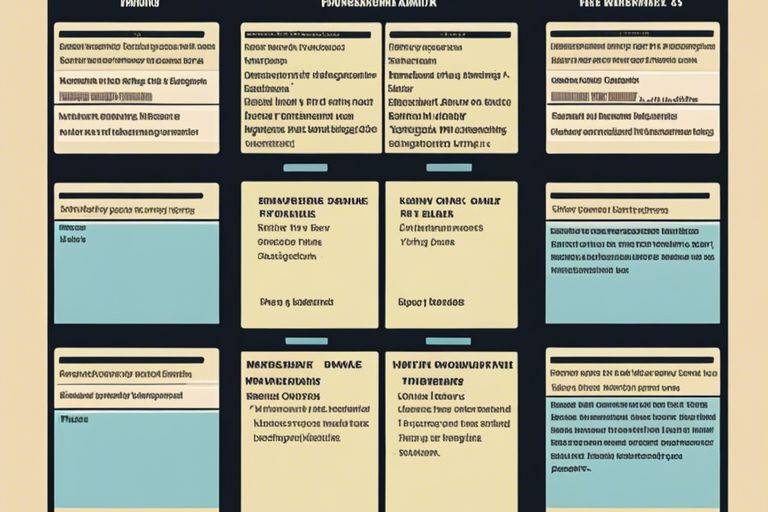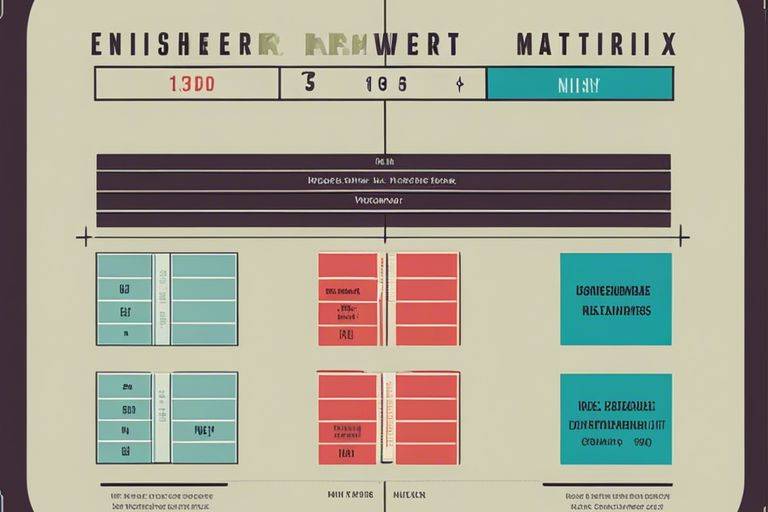Eisenhower Matrix! Many struggle with managing tasks effectively due to the overwhelming demands of daily responsibilities. This is where the Eisenhower Matrix, also known as the Urgent-Important Matrix, coined after the 34th President of the United States, Dwight D. Eisenhower, comes into play. This powerful strategy helps individuals categorize tasks based on their urgency and importance, allowing them to focus on what truly matters and increase productivity.

Key Takeaways:
- Urgent vs. Important: The Eisenhower Matrix helps differentiate between tasks that are urgent and those that are important, enabling efficient prioritization.
- Four Quadrants: Tasks are categorized into four quadrants based on their urgency and importance – Do First (Urgent & Important), Schedule (Important but not Urgent), Delegate (Urgent but not Important), and Don’t Do (Not Urgent or Important).
- Priority Setting: This technique assists in setting priorities by focusing on accomplishing high-priority tasks over low-priority ones.
- Time Management: By organizing tasks according to the Eisenhower Matrix, individuals can allocate their time effectively and concentrate on tasks that have the most significant impact.
- Productivity Tool: The Eisenhower Matrix acts as a productivity tool by helping individuals avoid procrastination and focus on completing tasks efficiently.
- Decision Making: It aids in making informed decisions by evaluating tasks based on their urgency and importance and determining the best course of action for each task.
- Stress Reduction: Prioritizing tasks using this method reduces stress and overwhelm by providing a structured approach to managing workload and responsibilities.


Eisenhower Matrix – Dwight D. Eisenhower’s Strategy to Prioritize Tasks by Urgency and Importance
There’s a powerful strategy called the Eisenhower Matrix, popularized by former U.S. President Dwight D. Eisenhower, that helps individuals prioritize tasks based on their urgency and importance. This tool is highly effective in improving productivity and time management by providing a clear framework for decision-making.
Definition of the Eisenhower Matrix
Understanding the Eisenhower Matrix begins with categorizing tasks into four quadrants based on two key criteria: urgency and importance. Urgency refers to how soon a task requires attention, while importance relates to how much a task contributes to your long-term goals or objectives. By visually organizing tasks into these categories, individuals can focus on what truly matters and avoid distractions that may hinder overall progress.
The Four Quadrants Explained
Understanding the four quadrants of the Eisenhower Matrix is crucial for effective task prioritization. Quadrant 1: Urgent and Important tasks require immediate attention and should be completed promptly to prevent negative consequences. Quadrant 2: Important but not Urgent tasks are key to long-term success and should be prioritized to prevent them from becoming urgent. Quadrant 3: Urgent but not Important tasks are often distractions that can be delegated or minimized. Quadrant 4: Neither Urgent nor Important tasks are low priority and should be eliminated or done during downtime.
The Eisenhower Matrix empowers individuals to make mindful decisions about how they allocate their time and energy. By focusing on tasks that align with their goals and values, individuals can increase productivity and achieve a greater sense of accomplishment.
Implementing the Eisenhower Matrix
Identifying Tasks for Each Quadrant
On your journey to master the Eisenhower Matrix, the first step is to identify tasks for each quadrant. Begin by listing out all your tasks and categorize them based on their urgency and importance. Urgent and important tasks go into Quadrant 1, important but not urgent tasks belong in Quadrant 2, urgent but not important tasks fall into Quadrant 3, and tasks that are neither urgent nor important should be placed in Quadrant 4.
Strategies for Prioritizing Tasks
The key to successfully prioritizing tasks using the Eisenhower Matrix lies in your ability to differentiate between what’s urgent and what’s important. Urgent tasks are those that require immediate attention to avoid negative consequences, while important tasks contribute to your long-term goals and success. By focusing on Quadrant 1 tasks first, you can prevent crises and stay on track with your goals. Delegate or schedule Quadrant 3 tasks to minimize distractions and maximize productivity. Quadrant 2 tasks are crucial for personal growth and should be given dedicated time and effort to foster development and progress.
Understanding the distinction between urgency and importance is necessary for effectively utilizing the Eisenhower Matrix. Urgency relates to time sensitivity, while importance pertains to the impact a task has on your goals and priorities. By regularly reassessing and updating your task list based on these criteria, you can streamline your workflow and achieve greater efficiency in your daily activities.
Time Management Principles Linked to the Eisenhower Matrix
Keep in mind that the Eisenhower Matrix is not just a tool for visually organizing tasks. It is deeply connected to fundamental time management principles that can help individuals make the most of their time and energy. By applying these principles, individuals can increase productivity and focus on what truly matters.
Connection with Pareto Principle (80/20 Rule)
Time management experts often emphasize the connection between the Eisenhower Matrix and the Pareto Principle, also known as the 80/20 Rule. This principle suggests that roughly 80% of results come from 20% of efforts. When using the Eisenhower Matrix, individuals can identify and prioritize the vital 20% of tasks that will contribute the most to their overall goals, enabling them to work more efficiently and effectively.
Relationship to Time Management Theories
Theories in time management, such as the ABC prioritization technique and the Time Blocking method, are closely related to the principles underlying the Eisenhower Matrix. These theories emphasize the importance of categorizing tasks based on their urgency and importance, allocating time effectively to high-priority tasks, and minimizing time wasted on low-value activities.
Applications of the Eisenhower Matrix
Personal Productivity Enhancement
Enhancement – The Eisenhower Matrix can be a powerful tool for enhancing personal productivity. By categorizing tasks into four quadrants based on their urgency and importance, individuals can clearly see where they should focus their time and energy. Tasks that fall into the “Important and Urgent” quadrant should be tackled immediately, while those in the “Important but Not Urgent” quadrant can be scheduled for later. This helps individuals prioritize their tasks and avoid the trap of constantly reacting to urgent but unimportant tasks.
Professional Project and Team Management
The – The Eisenhower Matrix is not only useful for personal productivity but also for professional project and team management. By using the matrix to assign tasks to team members based on their urgency and importance, project managers can ensure that the most critical tasks are addressed first. This can lead to more efficient project completion and reduced stress for team members. With this approach, project managers can also anticipate potential roadblocks and allocate resources effectively to meet project deadlines.

Tools and Technology for the Eisenhower Matrix
Digital Apps and Software
All productivity enthusiasts can benefit from using digital apps and software to implement the Eisenhower Matrix effectively. With the convenience of smartphones and computers, these tools allow users to organize tasks, set priorities, and track progress effortlessly. Some popular apps like Todoist, Trello, and Asana offer features that enable users to categorize tasks based on urgency and importance, making it easier to implement the Eisenhower Matrix in their daily routine.
Printable Templates and Planners
Technology may have revolutionized task management, but printable templates and planners still hold their value in helping individuals visualize and strategize their priorities. For instance, a simple printable Eisenhower Matrix template can be a powerful tool for those who prefer a tactile approach to task prioritization. By physically writing down tasks in the respective quadrants of the matrix, individuals can gain a clearer perspective on what needs immediate attention and what can be delegated or deferred.
Challenges and Limitations of the Eisenhower Matrix
Potential Misclassification of Tasks
Unlike other task management tools, the Eisenhower Matrix relies heavily on the user’s ability to accurately assess the urgency and importance of each task. This can lead to potential misclassification of tasks, where a task is mistakenly categorized as either urgent or important, leading to ineffective prioritization.
Tasks that are incorrectly labeled may end up receiving more attention than they deserve, while truly urgent and important tasks may be overlooked. It is crucial for users of the Eisenhower Matrix to regularly review and reassess their task classifications to ensure optimal efficiency.
Overcoming Paralysis by Analysis
Analysis paralysis is a common pitfall when using the Eisenhower Matrix, where individuals spend too much time analyzing and categorizing tasks instead of actually completing them. This can result in procrastination and a lack of progress on important tasks, ultimately hindering productivity.
One way to overcome paralysis by analysis is to set a time limit for task classification using the Eisenhower Matrix. By imposing a deadline for decision-making, individuals can avoid getting bogged down in overthinking and instead focus on taking action. It is important to remember that the primary goal of the Eisenhower Matrix is to prioritize tasks efficiently, not to dwell on categorization indefinitely.
Eisenhower
To wrap up
With this in mind, the Eisenhower Matrix is a powerful tool for anyone looking to improve their productivity and time management skills. By categorizing tasks based on urgency and importance, individuals can prioritize effectively and focus on what truly matters. This strategy, developed by former President Dwight D. Eisenhower, has stood the test of time and continues to be a valuable resource for individuals and organizations striving for efficiency and success. For further information on the Eisenhower Matrix, you can refer to The Eisenhower Matrix: Introduction & 3-Minute Video Tutorial.
FAQ
Q: What is the Eisenhower Matrix?
A: The Eisenhower Matrix, also known as the Urgent-Important Matrix, is a decision-making tool used to prioritize tasks based on their urgency and importance.
Q: Who created the Eisenhower Matrix?
A: The Eisenhower Matrix is named after Dwight D. Eisenhower, the 34th President of the United States, who was known for his ability to efficiently manage his time and priorities.
Q: How does the Eisenhower Matrix work?
A: The Eisenhower Matrix categorizes tasks into four quadrants based on their level of urgency and importance: Quadrant 1 (Urgent and Important), Quadrant 2 (Important but Not Urgent), Quadrant 3 (Urgent but Not Important), and Quadrant 4 (Not Urgent and Not Important).
Q: What tasks belong in Quadrant 1 of the Eisenhower Matrix?
A: Quadrant 1 tasks are both urgent and important. These tasks require immediate attention and should be top priorities.
Q: How should Quadrant 2 tasks be prioritized in the Eisenhower Matrix?
A: Quadrant 2 tasks are important but not urgent. These tasks should be scheduled and given appropriate time and attention to prevent them from becoming urgent in the future.
Q: Why is it important to differentiate between urgent and important tasks in the Eisenhower Matrix?
A: Distinguishing between urgent and important tasks helps individuals focus on what truly matters and avoid being overwhelmed by tasks that may not contribute significantly to their goals.
Q: How can the Eisenhower Matrix help in improving productivity and time management?
A: By using the Eisenhower Matrix to prioritize tasks, individuals can allocate their time and energy more effectively, reduce stress, and achieve a better balance between work and personal life.
Eisenhower Matrix! Expand Your Knowledge
The 50/10 Rule – Managing Work and Break Times for Enhanced Productivity
Unmatched Productivity – Ultimate Guide to Harnessing Your Second Brain
Eat That Frog – Brian Tracy’s Approach to Tackling the Most Challenging Task First
Pomodoro Technique – Francesco Cirillo’s Method to Improve Focus and Manage Time
Unlocking the Zeigarnik Effect: How Bluma Zeigarnik’s Open Tasks Can Skyrocket Your Motivation



